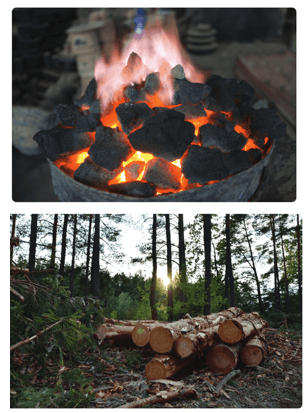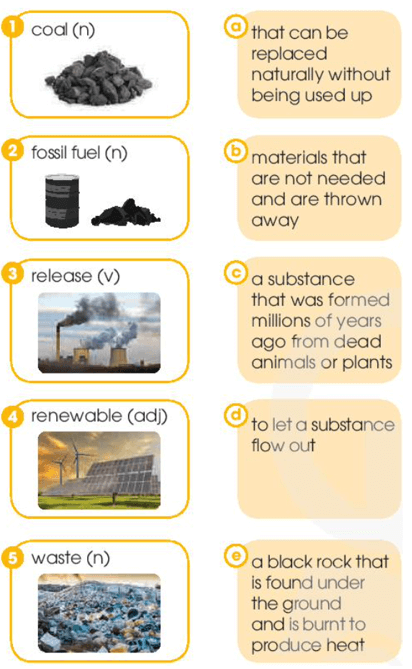Tự luận
CLIL
1 (trang 60 Tiếng Anh 11 Global Success): Read the text and tick (V) the pictures that show ways to reduce global warming (Đọc văn bản và đánh dấu (V) vào những bức tranh chỉ ra những cách để giảm sự nóng lên toàn cầu)
REDUCING THE ENVIRONMENTAL IMPACT OF FARMING
Farming provides us with the food that we eat every day. But farming activities also have a strong warming impact on the global temperature. The good news is that experts have already started thinking about how to reduce it.
Raising farm animals like cows, goats, and sheep makes the planet hotter. There are billions of them and they release methane, a greenhouse gas that is much more dangerous than carbon dioxide. That is why scientists are developing methane-catching face masks for cows. They are intended to reduce methane emissions by up to 50 per cent per cow.
Another farming activity that heats the atmosphere is growing rice. According to research, emissions from rice farms have the same warming effect as about 600 coal plants. Flooded rice fields also make it easier for soil bacteria to produce greenhouse gases. New farming methods have allowed rice to grow well in drier fields, limit the amount of greenhouse gases, use less water, and produce better crops.
In addition, land-use increases the global temperature. Plants and trees use CO2 to grow and store large amounts of carbon underground. Cutting down or burning forests to create farm fields and land for feeding animals releases tonnes of carbon dioxide and other greenhouse gases into the atmosphere every year. Luckily, many countries and world leaders have agreed to protect the forests and end deforestation.
In short, there are some positive signs that farmers can meet the environmental challenges. However, although the impact of farming on the global temperature has been reduced, there is still much to do.
Hướng dẫn dịch:
GIẢM THIỂU TÁC ĐỘNG MÔI TRƯỜNG CỦA CHĂN NUÔI
Nông nghiệp cung cấp cho chúng ta thực phẩm mà chúng ta ăn hàng ngày. Nhưng các hoạt động canh tác cũng có tác động nóng lên mạnh mẽ đối với nhiệt độ toàn cầu. Tin tốt là các chuyên gia đã bắt đầu nghĩ về cách giảm nó.
Chăn nuôi động vật trang trại như bò, dê và cừu làm cho hành tinh nóng hơn. Có hàng tỷ trong số chúng và chúng giải phóng khí mê-tan, một loại khí nhà kính nguy hiểm hơn nhiều so với carbon dioxide. Đó là lý do tại sao các nhà khoa học đang phát triển mặt nạ bắt khí mê-tan cho bò. Chúng nhằm mục đích giảm lượng khí thải mêtan lên tới 50% cho mỗi con bò.
Một hoạt động nông nghiệp khác làm nóng bầu không khí là trồng lúa. Theo nghiên cứu, khí thải từ các trang trại lúa có tác động làm ấm tương tự như khoảng 600 nhà máy điện than. Ruộng lúa bị ngập nước cũng tạo điều kiện cho vi khuẩn trong đất tạo ra khí nhà kính. Các phương pháp canh tác mới đã cho phép lúa phát triển tốt trên những cánh đồng khô hạn hơn, hạn chế lượng khí nhà kính, sử dụng ít nước hơn và cho năng suất vụ mùa tốt hơn.
Ngoài ra, việc sử dụng đất làm tăng nhiệt độ toàn cầu. Thực vật và cây cối sử dụng CO2 để phát triển và lưu trữ một lượng lớn carbon dưới lòng đất. Chặt phá hoặc đốt rừng để tạo ra các cánh đồng nông trại và đất để nuôi động vật thải ra hàng tấn carbon dioxide và các khí nhà kính khác vào bầu khí quyển mỗi năm. May mắn thay, nhiều quốc gia và các nhà lãnh đạo thế giới đã đồng ý bảo vệ rừng và chấm dứt nạn phá rừng.
Nói tóm lại, có một số dấu hiệu tích cực cho thấy nông dân có thể đáp ứng những thách thức về môi trường. Tuy nhiên, mặc dù tác động của canh tác nông nghiệp đối với nhiệt độ toàn cầu đã giảm, nhưng vẫn còn nhiều việc phải làm.

Bài làm:















